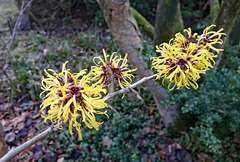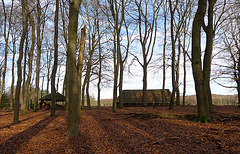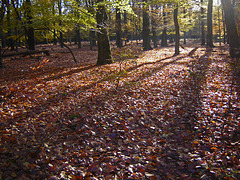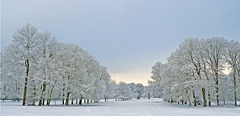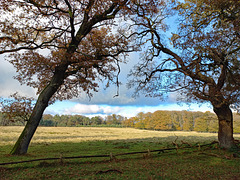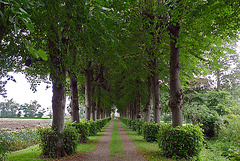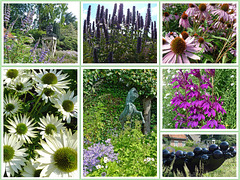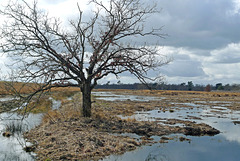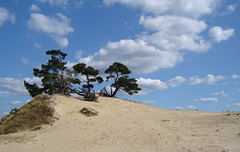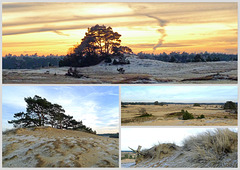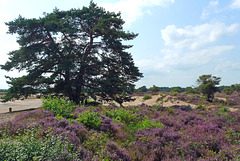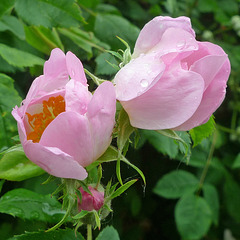
Nederland: natuur en landschap
Folder: Nederland - the Netherlands
Foto's van Nederlandse landschappen en natuur.
Voor foto's van bloembollen zie: www.ipernity.com/doc/294067/album/1303332
Voor foto's van bloembollen zie: www.ipernity.com/doc/294067/album/1303332
Nederland - Hoenderloo, toverhazelaar
| |
|
|
|
The special thing about the toverhazelaar (Witch Hazel) is that this shrub blooms in the winter months (from the end of December/beginning of January with yellow/orange spidery flowers).
The name toverhazelaar comes from the English "Witch-hazel", which is actually derived from "Wice-hazel". Because of this flexibility, this hazel is also said to have been frequently used as a dowsing rod.
The first witch-hazel imported into the Netherlands was the American 'Hamamelis virginiana'. This was a medicinal plant among the Indians. It is still used for medicinal purposes today
Nederland - Hoog Buurlo
Nederland - Hoog Buurlo
| |
|
|
|
Hoog Buurlo is a agricultural enclave amidst heathland, woods and beech avenues. Field farming, keeping sheep and chopping oak (tannic acid from oak bark was used in the tannery) provided the necessary income. Hoog Buurlo is most probably the smallest hamlet of the Netherlands, with two former farmhouses, two sheepfolds, just a couple of residents and over a hundred sheep.
The name (Hoog) Buurlo appears already in the 9th century and is a combination of "bur" (small house) and "lo" (forest). The hamlet is well known for its sheepfold and herd. It attracts many visitors, especially in spring when lambs are born.
Nederland - Hoog Soeren
| |
|
|
|
Grove of trees on the golf course of the Veluwse Golf Club.
PiP's: During winter (and snow) no golf players but children using their sleds.
Apeldoorn - Hoog Soeren, Groene Poeltje
| |
|
|
|
The Groene Poeltje (Little Green Puddle) is situated just outside the village of
Hoog Soeren in a small valley of a hill named Pomphul . The valley with the puddle has probably already had an attraction and significance for the inhabitants of this elevated part of the Veluwe in prehistoric times. The nearby burial mounds in prove that people lived here from an early age.
Due to the high altitude of Hoog Soeren, obtaining sufficient drinking water was often a problem in the past. Around 1800 a pump was installed in the valley of Pomphul. When in summer the rain barrels and wells in Hoog Soeren were dry, the villagers had to fetch water from Groene Poeltje with a barrel on a barrow. The trip with the heavy barrow back up to the village was quite a job. In 1927 the village became its own water piping.
Since the 17th century, however, a water pipe made of lead, wooden and earthenware pipes ran from Pomphul to the gardens of Het Loo Palace . The construction of this 13-kilometer long pipeline was commissioned by king Willem III. The difference in height of about 30 meters caused an enormous water pressure. The final result were 20 fountains, each 4 meters high and one fountain 13 meters high; the highest spouting fountain in Europe !!
Nederland - Hoog Soeren, Aardhuispark
| |
|
|
|
The Aardhuispark is a fenced-off part of Kroondomein Het Loo (The Loo Royal Estate). It is situated - as the name suggests - around Het Aardhuis . The park offers a mixture of open landscape with a wildlife meadow, lanes with old beech and oak trees and water pools.
A three-kilometre walking route has been marked out in the park. This route also leads to a hideout for wildlife spotting. During my last visit, I saw a group of 15 to 20 deer grazing and resting there (PiP1).
Nederland - Jelsum, Dekema State
| |
|
|
|
Dekema State: drive way from the Dekemawei to the mansion with lime trees pruned like a candelabrum. (De oprijlaan met gecandelaberde linden, ook wel 'zwarte singel' genoemd'.)
Nederland - Singer Laren, beeldentuin
| |
|
|
|
The Singer Laren sculpture garden is designed by Piet Oudolf, a well-known Dutch garden architect. The garden contains sculptures by contemporary Dutch artists, all of them on the theme of the relationship between culture and nature.
The Singer Laren sculpture garden is accessible free of charge.
Nederland - Klarenbeek, Beekbergerwoud
| |
|
|
|
Beekbergerwoud: a 'new' nature reserve, restored on the location of the last Dutch primeval forest, which was cut down in 1871.
Nederland - Kloosterhaar, Engbertsdijksvenen
| |
|
|
|
The Engbertsdijksvenen owes its name to the Engberts farming family. The area used to consist of a four to seven meter thick layer of peat that was formed around 10,000 years ago. The original peat bog was about 180,000 hectares in size. Peat extraction started relatively late and was a small-scale operation until the 19th century. Farmers used the peat for their own needs, for instance to stoke their stoves. At the beginning of the 20th century, the peat extraction of the Engbertsdijksvenen was done on a large scale and lasted until the middle of the last century.
From 1953, Staatsbosbeheer (a Dutch government organization for forestry and the management of nature reserves) bought land in the Engbertsdijksvenen . Peat was last excavated in 1984. The area covers an area of 1,000 ha. A small core of peat of about 17 ha still has its original thickness. Only 25 hectares of "living" raised bog remain in the Netherlands.
The Engbertsdijksvenen has been given a protected status in several respects. The Staatsnatuurmonument (National natural monument) has also been designated a Natura 2000 area. It is therefore part of a European network of high-quality nature reserves. It is an international wetland and the largest and most important raised bog area in Western Europe.
Nederland - Kootwijk, Kootwijkerzand
Nederland - Kootwijkerzand
| |
|
|
|
Kootwijkerzand is a drifting sand area on the Veluwe in the Dutch province of Gelderland. With an area of 700 ha is the largest shifting sand area in Western Europe. It is part of the Kootwijk forestry reserve.
Around 2500 BC, people already lived on the Kootwijkerzand . A flint arrowhead and some pottery remains from around 1700 BC have been found. In the second century AD, a few farms were built and from 700 AD one can speak of a village. In the Middle Ages, iron ore was collected and processed. For this purpose, forest was cut down on a large scale for the production of charcoal. The sandy soil was exposed and started to shift. As a result, the village disappeared under the sand in the 11th century.
Management measures are necessary to keep the sand of the Kootwijkerzand moving. Otherwise algae, mosses, lichens and higher plants will cover the sand. The sand is still really drifting. In strong winds, the loose sand blows away in certain places, and comes back down a bit further on. As a result, the terrain changes shape again and again, forming new sand dunes.
On the open sandy plain, the temperature can rise to 40 degrees Celsius, while the night temperature can also drop below 0 degrees in summer . The area is often called “the Dutch Sahara”.
Nederland - Kootwijkerzand, rijp
| |
|
|
|
Kootwijkerzand is a drifting sand area on the Veluwe in the Dutch province of Gelderland. With an area of 700 ha is the largest shifting sand area in Western Europe. It is part of the Kootwijk forestry reserve.
During our last visit on a cold clear day in December 2021 the landscape and the trees were partly covered (in the shade) with hoarfrost, which made a particularly charming and moody scene. Especially as during our walk we were just the two of us and didn't encounter any other people in this amazing drifting sand area.
Nederland - Kootwijkse Veld
| |
|
|
|
Blooming heath at the ‘Kootwijkse Veld’, nearby Stroe, a settlement at the edge of the Veluwe.
Nederland - Laren, Zuiderheide
| |
|
|
|
The Zuiderheide is one of the heathland areas in Het Gooi ; an area centred on the spur of the so called Utrechtse Heuvelrug (Utrecht Hill Ridge). The height differences in the area were created 120,000 years ago during the penultimate ice age. There are several ca. 4,000-year-old prehistoric burial mounds on the Zuiderheide , which protrude above the heathland like clearly recognisable green domes.
The southernmost part of the heathland - near Theehuis 't Bluk - consists of shifting sand, in fact a Dutch 'desert'. The sand that lies here was once brought by the polar storms of the last ice age.
After being pleasantly surprised by the beauty of the area last year, this year we visited especially for the blooming heather fields. And partly due to the wet spring, the Zuiderheide was also purple as purple can be !!
Nederland - Lauwersoog, Hondsroos
| |
|
|
|
The hondsroos (dog rose) is quite common in the Netherlands. I came across a lot of them during a walk in the National Park Lauwersmeer. Its flowers - blooming in June and July - are usually pale pink, but can vary between a deep pink and white. They are 4 - 6 centimeters in diameter with five petals.
The name hondsroos refers to ancient Greek medicine when the plant was used against hondsdolheid (= rabies).
Nederland - Loenen, waterval
| |
|
|
|
Waterfall of Loenen, one of the highest of the Netherlands. This waterfall in the so called ‘Vrijenbergspreng’ has a fall of 10 metres (in two steps). As a matter of fact there is a second waterfall downstream with four steps and about 15 metres high.
Nederland - Mantingerzand
| |
|
|
|
Mantingerveld consists of four small nature reserves, which are reduced to one large continuous area through activities of Natuurmonumenten (a Dutch society for nature conservation). The original landscape of the province of Drenthe with heathland, raised moors and fens must be restored over time.
Mantingerzand - one of the four reserves - lies somewhat higher and that made it uneconomical to cultivate the area in the past centuries. On maps from the beginning of the 17th century, the area is already clearly distinguishable; it has hardly changed since then. Mantingerzand is an area with shifting sand hills with countless juniper bushes on it. The reserve with juniper berries was acquired by Natuurmonumenten in 1920; one of the first purchases of the organisation in the province of Drenthe.
On the edge of the reserve are numerous old crooked oaks, which held the drifting sand. The oldest tree in the Mantingerzand is a pine, which has probably been here since 1840.
Jump to top
RSS feed- Latest items - Subscribe to the latest items added to this album
- ipernity © 2007-2024
- Help & Contact
|
Club news
|
About ipernity
|
History |
ipernity Club & Prices |
Guide of good conduct
Donate | Group guidelines | Privacy policy | Terms of use | Statutes | In memoria -
Facebook
Twitter

